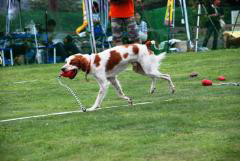Kong Cup Challenge

In one of the most exciting and fast-paced games, dogs have just one minute to accumulate as many points as possible by retrieving chewtoys of different point values from an enclosed retrieval area. Light-blue (water) Kongs are valued at 5 points, red Kongs at 3 points and black Kongs 1 point. The handler stands in a two-yard square Handler's Box within a five-yard square penalty box. In order for points to score, the handler must be able to take or pick up the object (with at least one part of their body remaining grounded in the Handler's Box) and place it in a plastic bucket. If the dog brings back a Bonus Kitty (soft toy) the final score is doubled, whereas if the dog’s paw enters or cuts the line of the Penalty Box while he is carrying a Penalty Bone in his jaws, the final score is halved. Retrieving a Kong Biscuit Ball increases the allotted retrieval time by 15 seconds. The dog with the highest score wins.
Training Tips
Practice as a group in many different places, with other dog’s Kongs and make sure to teach your dog discriminated-retrieves, i.e., your dog needs to be trained to reliably retrieve a Kitty or a blue Kong when requested.
Many owners fall into the comfortable trap of only training in familiar settings with familiar objects — the dog’s own Kongs. When it comes time to compete, the dog spends the entire minute running round the arena sniffing each Kong in turn looking for his own, and the final score is zero. It is important to practice with other dog’s Kongs and to do so in a variety of settings — in different people’s homes and yards and in parks and on walks. It is essential that your dog is as reliable in the arena as he is at home. Walk your dog with friends and their dogs and every 25 yards each person puts down a Kong for another dog to retrieve.
Many handlers think that it is sufficient to compete with a “retrieving fool” — a high-speed retriever who simply lives to retrieve and will bring back object after object non-stop. Usually they fair pretty well in competition because they bring back so many objects. However, sometimes their tally consists of toys with a low point value, or even Penalty Bones. For example, the dog may bring back ten objects within the one minute period — six black Kongs, two red Kongs and two penalty bones, the total score is only 3 points. Compare this to a dog (competing in the Toronto Sky Dome), who picked up three stuffed Kitties and shoveled the fourth Kitty back to his handler on his very first run. This meant that his next three retrieves — three blue Kongs — were each worth double-double-double-double 5 points (80 points) for a total score of 240.
To win this game your dog needs to be taught which specific objects he should retrieve. Teach your dog discriminated-retrieves in the same way that you would teach your dog to find your lost keys, or the remote control for the television.
Dogs that compete successfully in Kong Retrieve become absolutely Kong crazy and seldom become destructive chewers or excessive barkers when left at home alone. They have become Kongaholics and would much rather lie down and chew their food-stuffed Kongs than destroy the house or bark all day. Also, dogs are taught not even to touch, let alone pick up, forbidden articles, such as Penalty Bones but instead, to redirect their retrieving urges to Kongs.